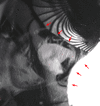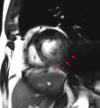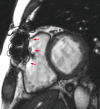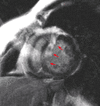Quality assessment of cardiovascular magnetic resonance in the setting of the European CMR registry: description and validation of standardized criteria
- PMID: 23787094
- PMCID: PMC3707748
- DOI: 10.1186/1532-429X-15-55
Quality assessment of cardiovascular magnetic resonance in the setting of the European CMR registry: description and validation of standardized criteria
Abstract
Background: Cardiovascular magnetic resonance (CMR) has become an important diagnostic imaging modality in cardiovascular medicine. However, insufficient image quality may compromise its diagnostic accuracy. We aimed to describe and validate standardized criteria to evaluate a) cine steady-state free precession (SSFP), b) late gadolinium enhancement (LGE), and c) stress first-pass perfusion images. These criteria will serve for quality assessment in the setting of the Euro-CMR registry.
Methods: Thirty-five qualitative criteria were defined (scores 0-3) with lower scores indicating better image quality. In addition, quantitative parameters were measured yielding 2 additional quality criteria, i.e. signal-to-noise ratio (SNR) of non-infarcted myocardium (as a measure of correct signal nulling of healthy myocardium) for LGE and % signal increase during contrast medium first-pass for perfusion images. These qualitative and quantitative criteria were assessed in a total of 90 patients (60 patients scanned at our own institution at 1.5T (n=30) and 3T (n=30) and in 30 patients randomly chosen from the Euro-CMR registry examined at 1.5T). Analyses were performed by 2 SCMR level-3 experts, 1 trained study nurse, and 1 trained medical student.
Results: The global quality score was 6.7±4.6 (n=90, mean of 4 observers, maximum possible score 64), range 6.4-6.9 (p=0.76 between observers). It ranged from 4.0-4.3 for 1.5T (p=0.96 between observers), from 5.9-6.9 for 3T (p=0.33 between observers), and from 8.6-10.3 for the Euro-CMR cases (p=0.40 between observers). The inter- (n=4) and intra-observer (n=2) agreement for the global quality score, i.e. the percentage of assignments to the same quality tertile ranged from 80% to 88% and from 90% to 98%, respectively. The agreement for the quantitative assessment for LGE images (scores 0-2 for SNR <2, 2-5, >5, respectively) ranged from 78-84% for the entire population, and 70-93% at 1.5T, 64-88% at 3T, and 72-90% for the Euro-CMR cases. The agreement for perfusion images (scores 0-2 for %SI increase >200%, 100%-200%,<100%, respectively) ranged from 81-91% for the entire population, and 76-100% at 1.5T, 67-96% at 3T, and 62-90% for the Euro-CMR registry cases. The intra-class correlation coefficient for the global quality score was 0.83.
Conclusions: The described criteria for the assessment of CMR image quality are robust with a good inter- and intra-observer agreement. Further research is needed to define the impact of image quality on the diagnostic and prognostic yield of CMR studies.
Figures












References
-
- Bruder O, Schneider S, Nothnagel D, Dill T, Hombach V, Schulz-Menger J, Nagel E, Lombardi M, van Rossum AC, Wagner A, Schwitter J, Senges J, Sabin GV, Sechtem U, Mahrholdt H. EuroCMR (European Cardiovascular Magnetic Resonance) Registry: results of the German Pilot Phase. J Am Coll Cardiol. 2009;54:1457–66. doi: 10.1016/j.jacc.2009.07.003. - DOI - PubMed
-
- Bruder O, Wagner A, Lombardi M, Schwitter J, van Rossum A, Pilz G, Nothnagel D, Steen H, Petersen S, Prasad S, Nagel E, Schumm J, Greulich S, Cagnolo A, Monney P, Deluigi C, Dill D, Frank H, Sabin S, Schneider S, Mahrholdt H. European Cardiovascular Magnetic Resonance (EuroCMR) Registry - Multi National Results from 57 Centers in 15 Countries. J Cardiovasc Magn Reson. 2013;15:9. doi: 10.1186/1532-429X-15-9. - DOI - PMC - PubMed
-
- Bruder O, Schneider S, Nothnagel D, Pilz G, Lombardi M, Sinha A, Wagner A, Dill T, Frank H, van Rossum A, Schwitter J, Nagel E, Senges J, Sabin G, Sechtem U, Mahrholdt H. Acute Adverse Reactions to Gadolinium-Based Contrast Agents in CMR: multicenter Experience With 17'767 Patients From the EuroCMR Registry. J Am Coll Cardiol - Cardiovasc Imaging. 2011;4:1171–76. doi: 10.1016/j.jcmg.2011.06.019. - DOI - PubMed
-
- Moschetti K, Muzzarelli S, Pinget C, Wagner A, Pilz G, Wasserfallen J-B, Schulz-Menger J, Nothnagel D, Dill T, Frank H, Lombardi M, Bruder O, Mahrholdt H, Schwitter J. Cost evaluation of cardiac magnetic resonance imaging versus coronary angiography for the diagnostic work-up of coronary artery disease: application of the European Cardiovascular Magnetic Resonance registry data to the German, United Kingdom, Swiss, and United States health care systems. J Cardiovasc Magn Reson. 2012;14:35. doi: 10.1186/1532-429X-14-35. - DOI - PMC - PubMed
-
- Schwitter J, Wacker CM, Wilke N, Al-Saadi N, Sauer E, Huettle K, Schönberg SO, Debl K, Strohm O, Ahlstrom H, Dill T, Hoebel N, Simor T. Superior diagnostic performance of perfusion-CMR versus SPECT to detect coronary artery disease: the secondary endpoints of the multicenter multivendor MR-IMPACT II. J Cardiovasc Magn Reson. 2012;14:61. doi: 10.1186/1532-429X-14-61. - DOI - PMC - PubMed
Publication types
MeSH terms
Substances
LinkOut - more resources
Full Text Sources
Other Literature Sources
Medical

